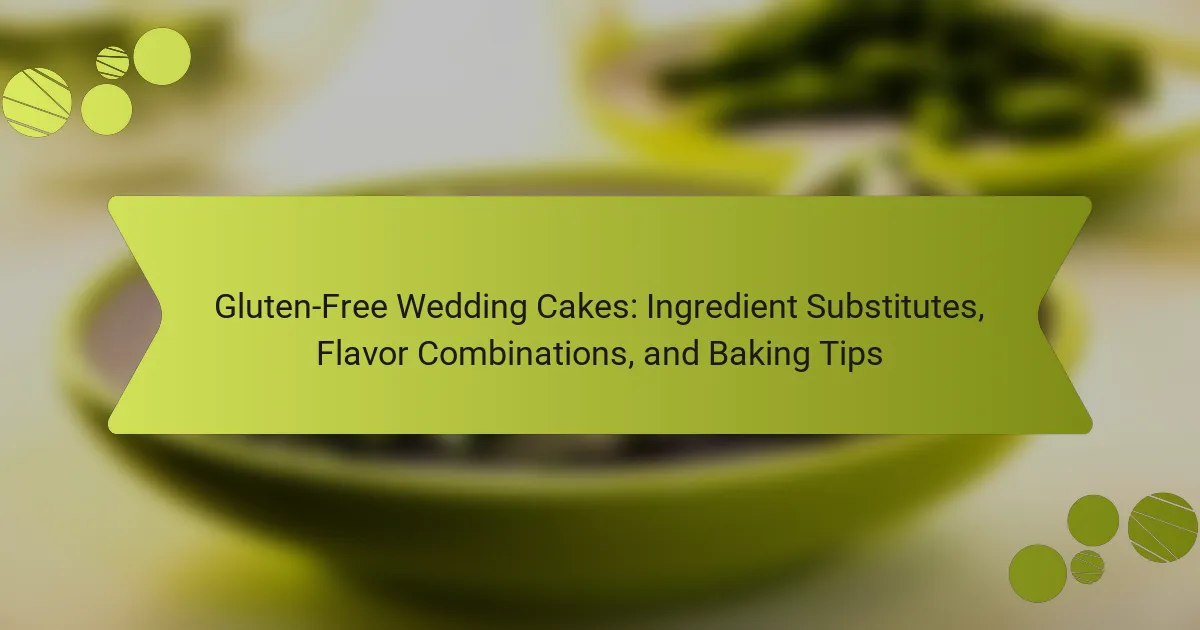Gluten-free wedding cakes are specially crafted desserts that exclude gluten-containing ingredients, catering to individuals with gluten sensitivities or celiac disease. Key gluten-free flours include almond flour, coconut flour, and rice flour, which can be combined with binding agents like xanthan gum or eggs to enhance texture. This article covers essential ingredient substitutes, popular flavor combinations such as almond and lemon or chocolate and raspberry, and practical baking tips to ensure a successful gluten-free cake. It highlights the growing trend of gluten-free options in the wedding industry, reflecting the dietary considerations of many couples during wedding planning.
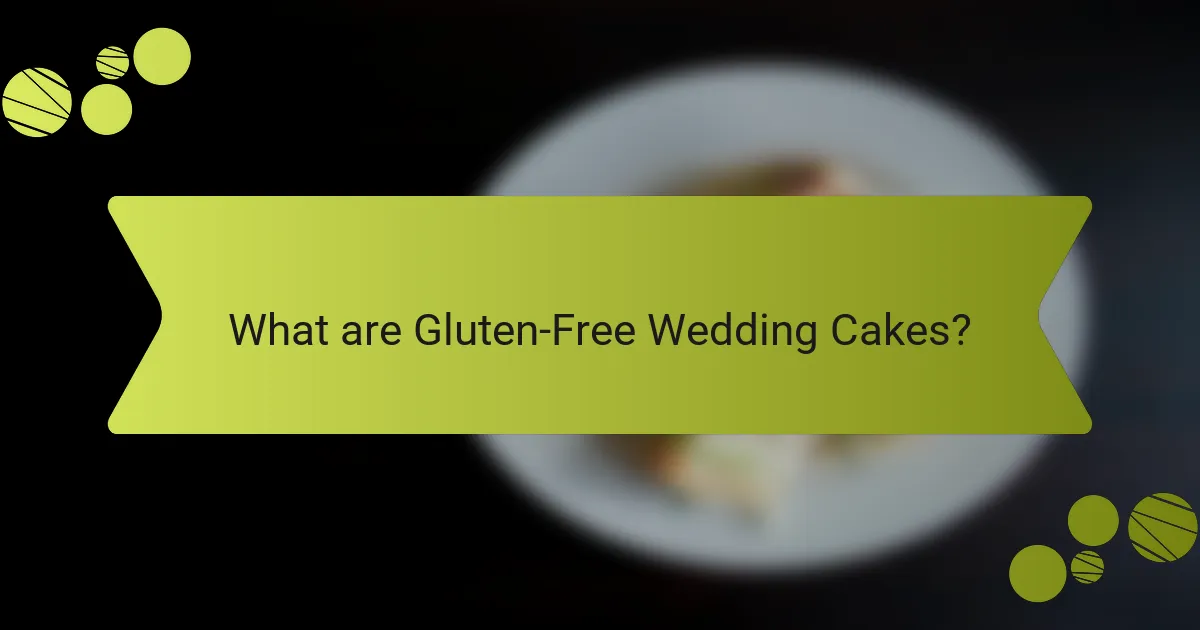
What are Gluten-Free Wedding Cakes?
Gluten-free wedding cakes are cakes made without gluten-containing ingredients. They are designed for individuals with gluten sensitivities or celiac disease. Common gluten-free flours include almond flour, coconut flour, and rice flour. These cakes can be just as flavorful and visually appealing as traditional cakes. Many bakers use additional binding agents like xanthan gum or eggs to improve texture. Gluten-free wedding cakes can be customized with various flavors and fillings. They are increasingly popular in the wedding industry, catering to diverse dietary needs. According to a survey by The Knot, 30% of couples consider dietary restrictions when planning their wedding menu.
How do gluten-free wedding cakes differ from traditional wedding cakes?
Gluten-free wedding cakes differ from traditional wedding cakes primarily in their flour composition. Traditional cakes use wheat flour, which contains gluten. Gluten-free cakes utilize alternative flours such as almond, coconut, or rice flour. These substitutes can alter the texture and moisture of the cake. Gluten-free cakes may require additional binding agents like xanthan gum or eggs to mimic gluten’s properties. The flavor profiles can also differ, as some alternative flours impart unique tastes. Additionally, gluten-free cakes often have a denser texture compared to their traditional counterparts. This difference is essential for accommodating guests with gluten sensitivities or celiac disease.
What ingredients are typically used in gluten-free wedding cakes?
Gluten-free wedding cakes typically use alternative flours such as almond flour, coconut flour, or rice flour. These flours provide structure and texture without gluten. Sugar is commonly used for sweetness, alongside eggs for binding and moisture. Dairy products like butter or milk are often included for richness. Additional ingredients may include baking powder for leavening and vanilla extract for flavor. Many recipes also incorporate fruits or nuts for added taste and texture. These ingredients ensure that gluten-free cakes are both delicious and celebratory.
Why is gluten-free important for certain dietary needs?
Gluten-free is important for certain dietary needs because it prevents adverse health effects in individuals with gluten sensitivities or disorders. Conditions such as celiac disease require strict avoidance of gluten. Consuming gluten can lead to severe gastrointestinal symptoms and long-term health complications. Research indicates that approximately 1% of the population has celiac disease, necessitating gluten-free diets for their health. Additionally, non-celiac gluten sensitivity affects a broader group, causing discomfort without the autoimmune response. For these individuals, gluten-free options are essential for maintaining overall well-being.
What are the benefits of choosing a gluten-free wedding cake?
Choosing a gluten-free wedding cake offers several benefits. It accommodates guests with gluten sensitivities or celiac disease. This ensures that everyone can enjoy the cake without health risks. Gluten-free cakes often use alternative flours like almond or coconut, which can enhance flavor and texture. Many people find gluten-free cakes to be moist and rich. Additionally, gluten-free options can cater to various dietary preferences, including vegan or paleo diets. This versatility allows for a broader range of flavor combinations. Gluten-free cakes can also be a unique selling point for the wedding, making it memorable. Overall, selecting a gluten-free wedding cake promotes inclusivity and creativity in dessert choices.
How can gluten-free wedding cakes accommodate various dietary restrictions?
Gluten-free wedding cakes can accommodate various dietary restrictions by using alternative flours and ingredients. Common substitutes include almond flour, coconut flour, and rice flour. These options are suitable for those with gluten intolerance or celiac disease. Additionally, cakes can be made dairy-free by using plant-based milk and oils. Egg replacements, such as applesauce or flaxseed meal, help cater to vegan diets. Sugar alternatives, like agave or stevia, can be used for those with sugar restrictions. The careful selection of ingredients ensures that the cake remains delicious while meeting diverse dietary needs.
What unique flavors can be achieved with gluten-free ingredients?
Gluten-free ingredients can achieve unique flavors such as nutty, fruity, and earthy profiles. Almond flour adds a distinct nuttiness to baked goods. Coconut flour introduces a subtle sweetness and tropical flavor. Quinoa flour contributes a mild, earthy taste. Rice flour offers a neutral base that allows other flavors to shine. The use of natural sweeteners like honey or maple syrup can enhance flavor complexity. Adding spices such as cinnamon or cardamom can elevate the overall taste. These ingredients create diverse flavor combinations suitable for gluten-free wedding cakes.
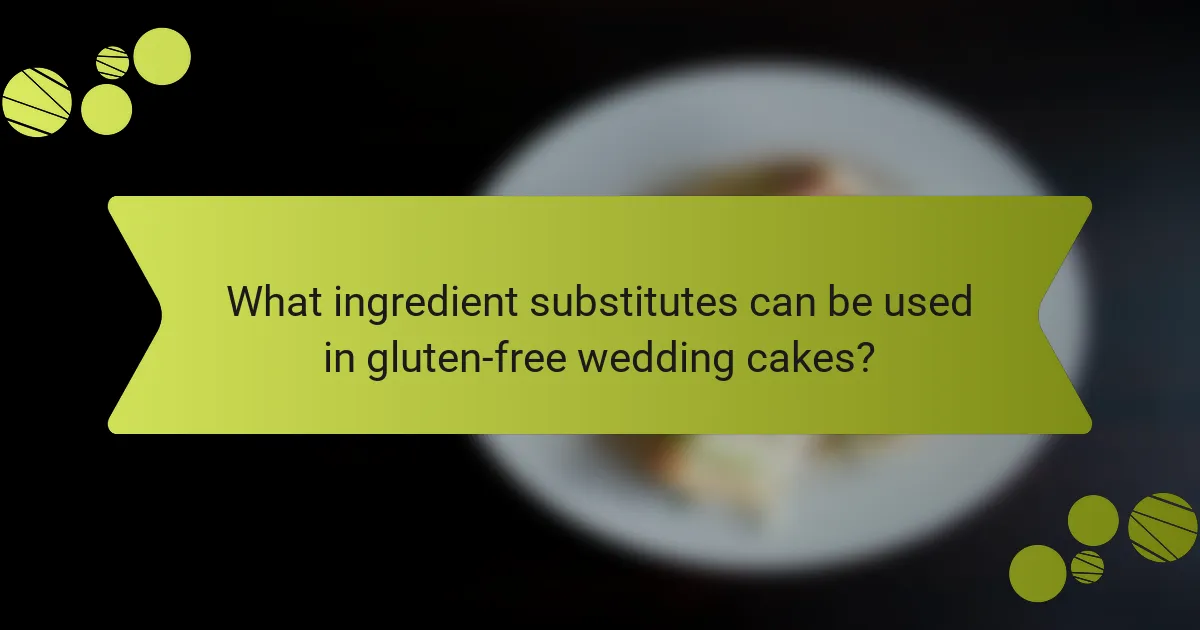
What ingredient substitutes can be used in gluten-free wedding cakes?
Almond flour and coconut flour are effective substitutes for traditional wheat flour in gluten-free wedding cakes. These flours provide a similar texture and flavor profile. Additionally, gluten-free all-purpose flour blends can be used for convenience. They often contain a mix of rice flour, potato starch, and tapioca flour.
For eggs, unsweetened applesauce or flaxseed meal mixed with water can serve as binding agents. These alternatives help maintain moisture and structure in the cake.
In place of dairy, almond milk or coconut milk can be used to achieve a rich flavor without gluten.
For sweeteners, honey or agave syrup can replace granulated sugar, adding moisture and sweetness.
These substitutions allow for a delicious gluten-free wedding cake without compromising taste or texture.
Which flours are the best alternatives to wheat flour?
Almond flour, coconut flour, and rice flour are the best alternatives to wheat flour. Almond flour is high in protein and healthy fats. It adds moisture and a nutty flavor to baked goods. Coconut flour is highly absorbent and requires more liquid in recipes. It is rich in fiber and gives a subtle sweetness. Rice flour is versatile and has a neutral flavor. It can be used in various recipes, including cakes and cookies. These flours are popular in gluten-free baking. They provide different textures and flavors compared to wheat flour.
How do almond flour and coconut flour compare in gluten-free baking?
Almond flour and coconut flour differ significantly in gluten-free baking. Almond flour is made from ground almonds and has a high-fat content. This contributes to moistness and a rich flavor in baked goods. Coconut flour, on the other hand, is made from dried coconut meat and is highly absorbent. It requires more liquid in recipes compared to almond flour.
In terms of texture, almond flour yields a denser product, while coconut flour can result in a lighter texture if used correctly. Almond flour typically has a neutral taste, making it versatile for various recipes. Coconut flour imparts a subtle coconut flavor, which may not be suitable for all baked goods.
Nutritionally, almond flour is higher in protein and healthy fats, whereas coconut flour is lower in calories and carbohydrates. When substituting one for the other, adjustments in liquid and egg content are necessary due to their differing absorbency levels. These factors make each flour suitable for different types of gluten-free baked goods.
What role do starches play in gluten-free cake recipes?
Starches play a crucial role in gluten-free cake recipes by providing structure and moisture. They help mimic the texture that gluten provides in traditional cakes. Common starches used include cornstarch, tapioca starch, and potato starch. These starches contribute to the cake’s lightness and tenderness. They also help bind ingredients together, preventing crumbling. The use of starches can enhance the cake’s overall flavor and mouthfeel. Studies show that the right balance of starches can improve the cake’s rise and texture. For instance, a blend of different starches often yields the best results in gluten-free baking.
What are some common binding agents for gluten-free cakes?
Common binding agents for gluten-free cakes include eggs, applesauce, and flaxseed meal. Eggs provide structure and moisture, helping to bind ingredients together. Applesauce acts as a natural binder and adds sweetness. Flaxseed meal, when mixed with water, forms a gel-like substance that mimics egg properties. Other options include chia seeds and yogurt, which also enhance moisture and binding. These agents are essential for achieving the desired texture in gluten-free baking.
How do eggs and flaxseed meal function as binders in gluten-free baking?
Eggs and flaxseed meal act as binders in gluten-free baking by providing structure and moisture. Eggs contain proteins that coagulate when heated, helping to hold ingredients together. They also add richness and improve texture in baked goods. Flaxseed meal, when mixed with water, forms a gel-like consistency that mimics the binding properties of eggs. This gel helps to stabilize the mixture and prevent crumbling. Both ingredients contribute to the overall cohesiveness of gluten-free recipes. Studies show that using these binders enhances the quality of gluten-free products, making them more palatable and structurally sound.
What are the benefits of using xanthan gum or guar gum?
Xanthan gum and guar gum serve as effective thickening and stabilizing agents in gluten-free baking. They enhance the texture and moisture retention of baked goods. Xanthan gum provides elasticity, mimicking the properties of gluten. Guar gum improves the overall consistency and volume of the batter. Both gums help prevent crumbling in gluten-free cakes. They also support better gas retention during baking, resulting in a lighter product. Studies show that using these gums can significantly improve the sensory qualities of gluten-free cakes. Their ability to bind water contributes to a more appealing final texture.
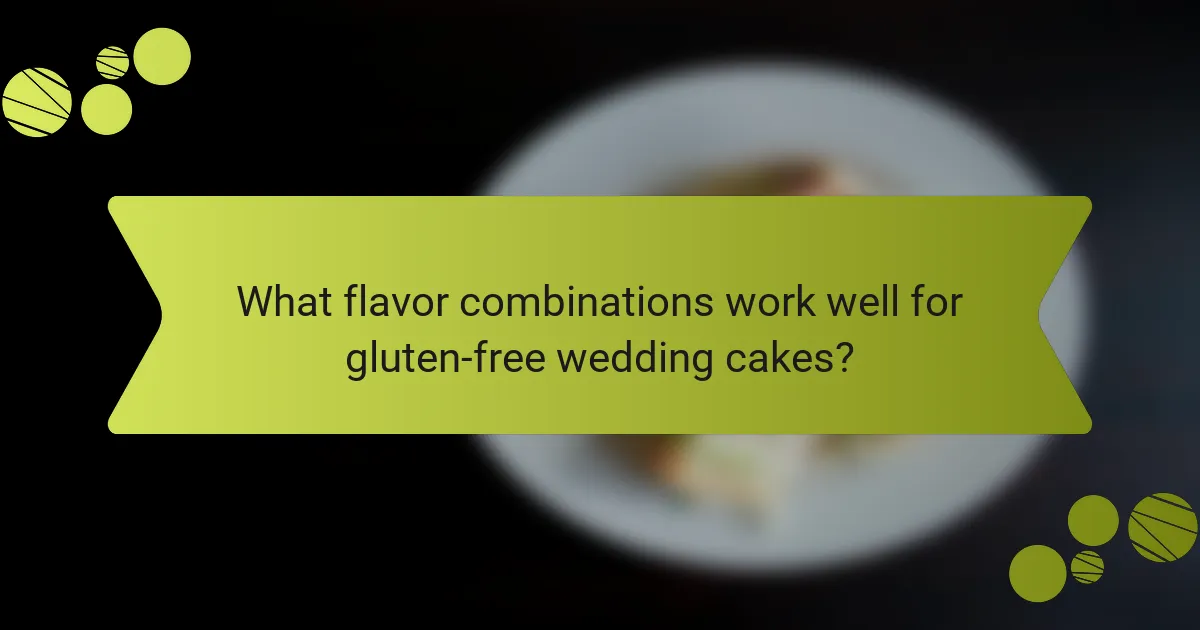
What flavor combinations work well for gluten-free wedding cakes?
Popular flavor combinations for gluten-free wedding cakes include almond and lemon, chocolate and raspberry, and vanilla and coconut. Almond flour pairs well with lemon zest, creating a light and refreshing taste. Chocolate cake can be enhanced with raspberry filling, providing a rich and fruity contrast. Vanilla cake blends beautifully with coconut cream, adding a tropical flair. These combinations are commonly used and appreciated for their balance of flavors.
How can traditional flavors be adapted for gluten-free recipes?
Traditional flavors can be adapted for gluten-free recipes by using gluten-free flour alternatives. Common substitutes include almond flour, coconut flour, and rice flour. These flours can mimic the texture and taste of wheat flour in many recipes. Additionally, incorporating flavor enhancers like vanilla extract or spices can elevate the taste.
For example, almond flour adds a nutty flavor that complements traditional cakes. Coconut flour provides a slight sweetness and moisture. Using these alternatives allows bakers to maintain the essence of traditional flavors.
Research shows that gluten-free baking can achieve similar results to conventional baking with the right substitutions. The Gluten-Free Certification Organization states that using a blend of gluten-free flours often yields the best texture and flavor.
What are popular flavor pairings for gluten-free wedding cakes?
Popular flavor pairings for gluten-free wedding cakes include almond and raspberry, lemon and blueberry, and chocolate and orange. Almond pairs well with raspberry for a sweet, nutty flavor. Lemon and blueberry create a refreshing, tart combination. Chocolate and orange offer a rich, zesty taste. Other options include vanilla and coconut, which provide a tropical feel. Additionally, carrot and pineapple create a moist, flavorful cake. These pairings enhance the overall taste and appeal of gluten-free wedding cakes.
How can fruits and spices enhance gluten-free cake flavors?
Fruits and spices enhance gluten-free cake flavors by adding natural sweetness and complex aromas. Fruits like bananas and applesauce provide moisture and sweetness, reducing the need for added sugars. Citrus zest, such as lemon or orange, brightens the cake’s flavor profile. Spices like cinnamon, nutmeg, and vanilla create warmth and depth in taste.
Studies show that incorporating these ingredients can improve overall flavor perception. For example, a study published in the Journal of Food Science found that cakes with added fruit or spices received higher flavor ratings. This indicates that they significantly impact the sensory experience of gluten-free cakes.
What unique flavor profiles can be explored in gluten-free baking?
Unique flavor profiles in gluten-free baking include nutty, fruity, and spiced variations. Nut flours, such as almond or hazelnut, add depth and richness. Coconut flour introduces a tropical sweetness. Using gluten-free grains like quinoa or buckwheat can impart earthy notes. Incorporating fruits, such as citrus or berries, enhances freshness and vibrancy. Spices like cinnamon, cardamom, and ginger can elevate the flavor complexity. These profiles can be combined for innovative recipes, creating unique taste experiences. Each ingredient contributes distinct characteristics, allowing for creative exploration in gluten-free baking.
How can chocolate and vanilla be creatively combined in gluten-free cakes?
Chocolate and vanilla can be creatively combined in gluten-free cakes by using a marbling technique. This involves swirling chocolate batter and vanilla batter together in the cake pan. The result is an appealing visual effect and a blend of flavors.
Another method is to layer chocolate and vanilla cakes. Alternating layers can create a striking presentation. Additionally, chocolate ganache can be used as a filling between layers of vanilla cake.
Incorporating chocolate chips into vanilla batter adds texture and flavor. Conversely, vanilla extract can enhance the chocolate batter’s taste.
Using gluten-free flour blends ensures the cake maintains the desired texture. This combination allows for a rich flavor profile while accommodating dietary restrictions.
What are some innovative flavor ideas for contemporary gluten-free wedding cakes?
Innovative flavor ideas for contemporary gluten-free wedding cakes include lavender lemon, matcha green tea, and almond raspberry. Lavender lemon offers a floral note balanced with citrus. Matcha green tea provides an earthy flavor and vibrant color. Almond raspberry combines nutty richness with tart sweetness. Other unique options include chai spice, coconut lime, and chocolate orange. Each flavor introduces distinct tastes and aromas, enhancing the wedding cake experience. These combinations cater to diverse palates while ensuring gluten-free requirements are met.
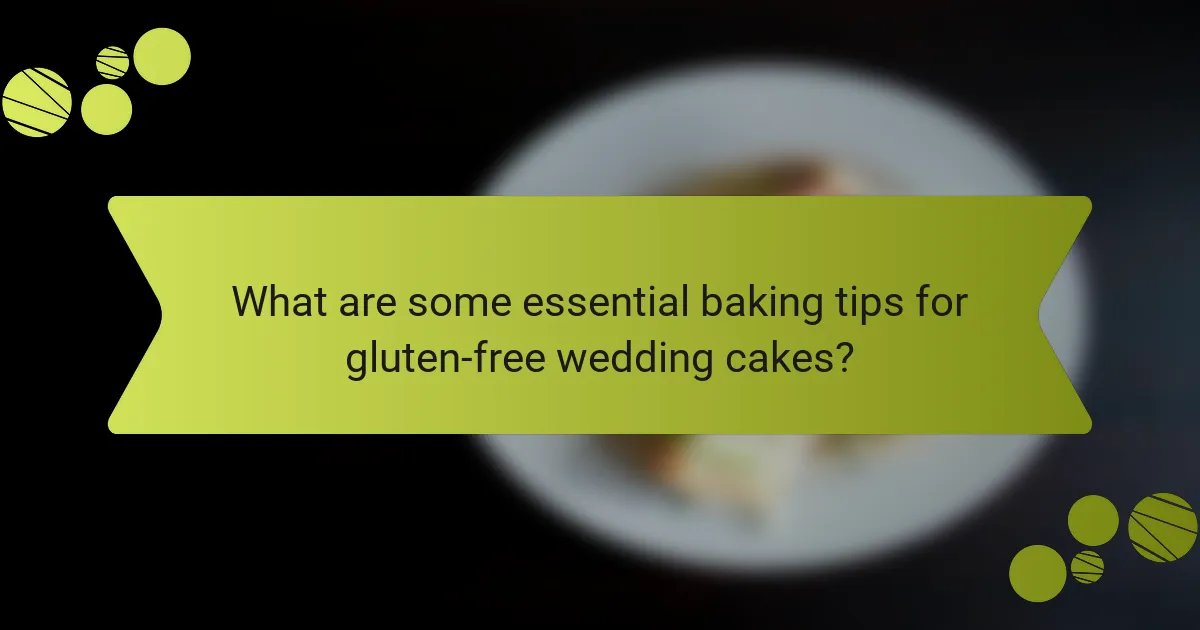
What are some essential baking tips for gluten-free wedding cakes?
Use a blend of gluten-free flours for better texture. Common combinations include almond flour, coconut flour, and rice flour. Incorporate xanthan gum or guar gum to mimic gluten’s elasticity. Adjust baking time and temperature as gluten-free cakes may bake faster. Ensure all ingredients are certified gluten-free to avoid cross-contamination. Use moist ingredients like applesauce or yogurt to enhance flavor and moisture. Consider adding flavor extracts to improve taste. Test the cake with a toothpick to check for doneness, as gluten-free cakes can be tricky.
How can bakers ensure a moist and fluffy gluten-free cake?
Bakers can ensure a moist and fluffy gluten-free cake by using a combination of high-quality gluten-free flour blends and adding moisture-rich ingredients. Gluten-free flour blends often contain starches and proteins that mimic gluten’s structure. Incorporating ingredients like yogurt, applesauce, or sour cream can enhance moisture levels.
Bakers should also consider adding eggs, which provide structure and moisture to the cake. Mixing the batter just until combined prevents overworking the flour, which can lead to a denser texture. Using baking powder or baking soda effectively helps the cake rise, contributing to a fluffy texture.
Finally, baking at the appropriate temperature and checking for doneness with a toothpick ensures the cake remains moist without overbaking. These techniques are supported by various baking resources that emphasize the importance of moisture and structure in gluten-free baking.
What techniques can be used to prevent crumbling in gluten-free cakes?
To prevent crumbling in gluten-free cakes, use a combination of techniques that enhance moisture and structure. Incorporate binding agents like xanthan gum or guar gum. These ingredients help replicate the elasticity typically provided by gluten.
Use a blend of gluten-free flours, such as almond flour and coconut flour. This combination can improve texture and moisture retention. Adding eggs also contributes to structure and moisture, making the cake less likely to crumble.
Incorporate additional liquids, such as yogurt or applesauce, to enhance moisture content. Baking at the correct temperature and for the right duration is crucial for achieving the desired texture.
Finally, allow the cake to cool completely before removing it from the pan. This step minimizes the risk of crumbling. These techniques collectively contribute to a more stable gluten-free cake.
How important is the baking time and temperature for gluten-free cakes?
Baking time and temperature are crucial for gluten-free cakes. Gluten-free batters behave differently than traditional ones. Precise baking times prevent undercooking or overcooking. The ideal temperature often ranges from 325°F to 350°F. This range helps achieve the right texture and moisture level. Underbaking can lead to a gummy texture. Overbaking may result in a dry cake. Therefore, monitoring both factors ensures the best outcome for gluten-free cakes.
What troubleshooting tips can help with gluten-free cake baking?
Use the right gluten-free flour blend for baking. A blend with xanthan gum or guar gum helps mimic gluten’s structure. Adjust the liquid content based on the flour used. Gluten-free flours often absorb more moisture. Monitor baking time closely, as gluten-free cakes may bake faster. Use a toothpick to check for doneness. Ensure proper mixing to avoid lumps, which can affect texture. Let the cake cool completely before removing it from the pan to prevent crumbling.
How can bakers fix common issues like dryness or density in gluten-free cakes?
Bakers can fix dryness in gluten-free cakes by adding moisture-rich ingredients. Common options include yogurt, applesauce, or mashed bananas. These ingredients enhance texture and flavor while preventing dryness. To address density, bakers should incorporate lighter gluten-free flours like almond or coconut flour. Adding baking powder or baking soda can also help create a lighter crumb. The use of eggs contributes to structure and moisture, improving overall cake quality. Adjusting baking time and temperature can further assist in achieving the desired texture. Many bakers report success with these methods, leading to improved gluten-free cake outcomes.
What should be done if the cake doesn’t rise as expected?
If the cake doesn’t rise as expected, check the baking powder or baking soda for freshness. Expired leavening agents can prevent proper rising. Ensure the oven temperature is accurate, as incorrect heat can affect the cake’s rise. Additionally, avoid overmixing the batter, which can lead to a dense texture. Also, ensure that the ingredients are measured correctly, as inaccuracies can impact the cake’s ability to rise. Lastly, consider adding an extra egg, as eggs contribute to the leavening process in baking.
What are the best practices for decorating gluten-free wedding cakes?
Use fondant or buttercream for gluten-free wedding cake decoration. These options provide a smooth surface and can easily hide imperfections. Ensure all ingredients used in decorations are certified gluten-free. This prevents cross-contamination and ensures safety for gluten-sensitive guests. Utilize natural food colorings for vibrant decorations. These are often gluten-free and healthier than artificial alternatives. Incorporate fresh fruits or edible flowers for a natural aesthetic. This adds color and texture without gluten concerns. Consider using gluten-free sprinkles or edible glitter for added flair. These can enhance the visual appeal without compromising dietary restrictions. Always communicate with clients about the gluten-free status of all decorations. This transparency builds trust and ensures guest safety.
How can gluten-free frostings be made and applied effectively?
Gluten-free frostings can be made using alternative thickeners and sweeteners. Common ingredients include powdered sugar, butter, and gluten-free flavorings. For a smooth texture, cream the butter first before adding sugar. Incorporate milk or dairy-free alternatives to achieve desired consistency. Use gluten-free vanilla extract or cocoa powder for flavor. To apply effectively, ensure the cake is completely cooled. Use a spatula for even spreading. For decorative piping, utilize a piping bag with a suitable tip. This method ensures a professional finish.
What are some creative decoration ideas that complement gluten-free cakes?
Edible flowers are a popular decoration that complements gluten-free cakes. They add color and elegance. Fresh berries can also enhance the visual appeal. They provide a burst of flavor and natural sweetness. Whipped cream or dairy-free alternatives can be used for a classic finish. Drizzling chocolate or fruit sauces adds a delicious touch. Fondant decorations can create intricate designs while being gluten-free. Finally, nuts and seeds can be sprinkled for added texture and flavor. These decoration ideas enhance the overall presentation of gluten-free cakes.
Gluten-free wedding cakes are specially crafted cakes that exclude gluten-containing ingredients, making them suitable for individuals with gluten sensitivities or celiac disease. This article covers the key attributes of gluten-free wedding cakes, including common ingredient substitutes like almond and coconut flour, as well as unique flavor combinations such as almond raspberry and lavender lemon. It also provides essential baking tips to ensure a moist and fluffy texture, discusses the role of binding agents and starches, and offers decoration ideas that complement these cakes while adhering to dietary restrictions. Overall, the content aims to inform readers about the diverse options and considerations involved in creating gluten-free wedding cakes.
